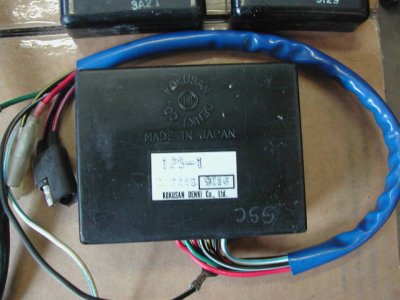blitz11
Silver Level Site Supporter
I've been pondering the statement, "The CDIs do have different curves. They vary by year and displacement, some years the 250s and 300s having different curves" because of what iancp5 said:
"This is quite an interesting thread. I wonder if it accounts for the some GG's don't idle properly issue?"
The question is whether these differences are design differences or the result of variance in part tolerance for the ignition assembly.
I just checked the GoFasters' parts fische, and it shows 2004 - 2007 250s and 300s having the same ignition CDI box. From a parts inventory standpoint (at least in the latter years), displacement and year don't seem to affect the part number (ME250534077). Actually, from that part number, the CDI box hasn't changed since the 2000 model year.
The 200 CDI box is the same part number, too, perhaps dispelling the difference in 200 vs. 250 vs. 300 CDI advance curves. I say "perhaps" because I am only speculating. I don't really know.
The other thought i had would be whether GG has enough time to do a "study" on the variance between CDIs. How do they get enough time to sample enough CDIs to determine whether variance in CDIs has much influence on engine performance? Given their size, they probably don't.
When visiting the factory, the engine pre-installation test cell has one CDI box for 2T engines and one CDI box and one FI box for 4T engines. They test engine performance against the standard ignition. They don't test the assembled system to measure the system performance. (They install the CD box on the assembly line).
Thus, they have data for the engine, but not the system. They don't run a chassis dyno at the end of the assembly line, so the system might be highly sensitive to production variance in the CDI. They might not know, just as we don't. It could be production differences in the CDI can account for significant performance differences in individual bikes.
OK. Just thinking out loud. Back to work.
blitz
"This is quite an interesting thread. I wonder if it accounts for the some GG's don't idle properly issue?"
The question is whether these differences are design differences or the result of variance in part tolerance for the ignition assembly.
I just checked the GoFasters' parts fische, and it shows 2004 - 2007 250s and 300s having the same ignition CDI box. From a parts inventory standpoint (at least in the latter years), displacement and year don't seem to affect the part number (ME250534077). Actually, from that part number, the CDI box hasn't changed since the 2000 model year.
The 200 CDI box is the same part number, too, perhaps dispelling the difference in 200 vs. 250 vs. 300 CDI advance curves. I say "perhaps" because I am only speculating. I don't really know.
The other thought i had would be whether GG has enough time to do a "study" on the variance between CDIs. How do they get enough time to sample enough CDIs to determine whether variance in CDIs has much influence on engine performance? Given their size, they probably don't.
When visiting the factory, the engine pre-installation test cell has one CDI box for 2T engines and one CDI box and one FI box for 4T engines. They test engine performance against the standard ignition. They don't test the assembled system to measure the system performance. (They install the CD box on the assembly line).
Thus, they have data for the engine, but not the system. They don't run a chassis dyno at the end of the assembly line, so the system might be highly sensitive to production variance in the CDI. They might not know, just as we don't. It could be production differences in the CDI can account for significant performance differences in individual bikes.
OK. Just thinking out loud. Back to work.
blitz




